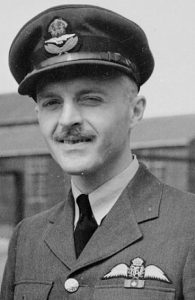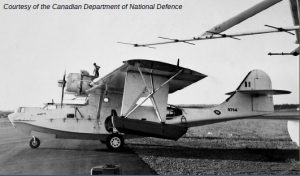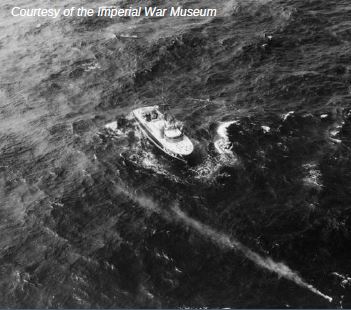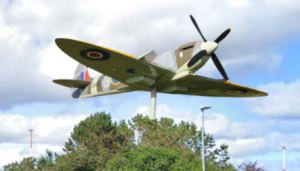Site 29. F/LT David Hornell VC
On the 24th June, 1944, Flight Lieutenant David Hornell of 162 Squadron Royal Canadian Air Force and his crew of seven, took off from RAF Wick at 09:30 hours flying a Canadian Vickers PBV Canso amphibian aircraft (Tail No. 9754F) on an anti-submarine patrol over the North Atlantic. The patrol route had the aircraft searching between Shetland and the Faroes but after 10 hours without sighting any U-boats, Hornell decided to return to Wick.

Suddenly, two of the crew spotted a surfaced U-boat approximately 5 miles (8 Km) off their port beam. Hornell swung the aircraft around to carry out an attack. Spotting the approaching seaplane, the crew of U-1225 opened fire with its twin 20mm flak gun. Hornell took what evasive action he could without deviating too far from his attack heading, but accurate fire from the submarine impacted the aircraft, destroying the radio antennas. 20mm shells impacted the starboard wing and engine which burst into flames. Despite finding the aircraft almost impossible to fly due to the damage, Hornell used every bit of his skill and ounce of his strength to press home the attack. As the aircraft dived towards the U-boat the Canso’s gunners opened fire in an attempt to knock out the German flak gun, but the 20mm shells kept tearing into the fuselage, destroying one of the aircraft’s survival rafts.

With his aircraft ablaze, Hornell released his depth charges directly over the top of the U-boat from an altitude of 50 feet (16m). The depth charges straddled the submarine and detonated beneath the hull, blowing the bow off the U-boat. Mortally damaged, U-1225 sank with all 56 of her crew after having spent only eight days at sea on its very first war patrol. With the U-boat now sunk, Hornell hauled on the control column in an attempt to gain as much altitude as possible, but with the wing now weakened by the fire the starboard engine ripped away from its mountings and fell into the sea. With smoke filling the cockpit and fuselage, Hornell turned into the wind as the Canso plummeted towards the sea below.
The aircraft bounced twice on the rough waves before coming to rest, its starboard wing engulfed in flames. The crew immediately deployed their only surviving four-man survival dinghy and evacuated the aircraft as it slipped beneath the surface. As darkness descended, the crew took turns either resting in the dinghy or half-submerged in the frigid waters clutching its side. The seas grew steadily rougher, and the crew huddled together trying to stay warm. At midnight, a passing Catalina from 333 Norwegian Squadron spotted distress flares and altered course to investigate. Upon sighting the crew in the raft and in the water, the Catalina reported the situation to Coastal Command, who in turn scrambled two Vickers Warwicks from Wick at 00:44 hours, and a High-Speed Launch (HSL 2506) from Scalloway on Shetland. The two Warwicks searched for several hours but were unable to locate the dinghy so a third Warwick took off from Wick at 07:46 to continue the search.

Hornell attempted to keep up his crew’s spirits but sadly, Sergeant St. Laurent succumbed to exposure during the night and his body was committed to the deep. At 10:40 hours, Warwick FA-M of 281 Air Sea Rescue Squadron from Wick located the survivors and attempted to air-drop a lifeboat, but the release mechanism malfunctioned and the lifeboat landed 550 yards (500m) away from the dinghy.

Despite being weak from the cold, Hornell attempted to swim towards the lifeboat, but was restrained by his crew as he would never have made it. Three hours later, Sergeant Scott also died from exposure, and he too was committed to the sea. By now a Short Sunderland flying boat had arrived on scene but the sea conditions were too rough for the aircraft to land. Another 90 minutes passed before HSL 2507 eventually arrived to rescue the crew. By now Hornell was unconscious and unresponsive and had to be hoisted aboard the launch. Despite every effort by the rescue team, he died within 15 minutes of being rescued.
For his bravery Flight Lieutenant Hornell was posthumously awarded the Victoria Cross, Britain’s highest award for gallantry. He was also the first member of the RCAF, and one of only two RCAF personnel, to be awarded the Victoria Cross during the Second World War.




